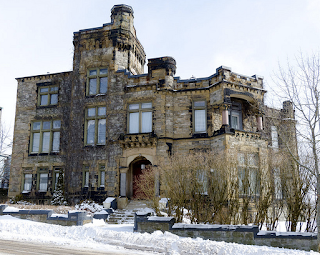The house is grand by any measure. It has a 29 foot long dining room, and a 35 foot long living room as well as a library. Deep in the heart of Saint John, the Bay of Fundy is visible from the master bedroom. Even though the house has gone through a number of uses over the years, it has remained largely true to its historical origins. This image below of the dining area gives a sense of the inside of the house which includes many decorative wall and ceiling covers, and extensive use of stained glass.

The former servant quarters are now separate apartments, and for the past number of years it has served as a private residence along with rental apartments. It has also, at various times, served as a military headquarters, an officer's club, and a night club.
There are several histories of the property online. It was built, some accounts starting in 1879 (other accounts say 1881), for Mr. Simeon Jones. His original house had been burnt to the ground in the the Great Fire of 1877. The house was based on a similar structure in Montreal, and the architect for that house was hired to consult on this property. Mr. Jones at first worked in the brewery business eventually becoming an owner (in 2010 a Maritime beer was named in his honour). He (with associates) started a bank in 1874, and his three sons took over the brewery business in 1879. He was elected as an alderman in 1879 and subsequently became the mayor of Saint John.
While a number of public buildings constructed in that era used limestone, it was relatively rare in New Brunswick in private homes. The integration of polished granite with the limestone, on short exterior pillars, and several places on the entrance (shown below) add significantly to the architectural feel.
There are conflicting reports (some attribute it to the name of a daughter in law) of the naming of the hall, but the most definitive accounts attribute it to Simeon Jones grandmother Jane Elizabeth Caverhill. Caverhill Hall is listed in the Saint John Tourism Walking Tours Guide available on the web. Part of the account written there says "Caverhill Hall in its heyday hosted a King, a Queen and a Prime Minister. It was built by a brewer, Simeon Jones and took its name from his grandmother, Jane Elizabeth Caverhill... Simeon Jones was mayor of Saint John throughout the construction period. Upon its completion, the Jones’ hosted a reception for Sir. John A. and Lady MacDonald and 250 guests. In 1901, the Duke and Duchess of York, who became KingGeorge V and Queen Mary, used the house." As noted the house was loaned for use by the Prince of Wales and the Duke and Duchess of Cornwall and York during their October 1901visit to Saint John. The house was re-decorated in grand style in the months leading up to this royal visit, and this event was widely reported in local and national media. A reprinting of a book about the royal tour is available on Amazon.
While a number of grand properties with interesting histories are for sale in Atlantic Canada currently, this could arguably claim to be the finest private home on the market.
Photo credits: The opening photo is from the current real estate listing for the property by DeCourcey and Company. The other two photos are modified forms of several provided on an archived site about Caverhill by Katherine Bacon, Fine Home Specialist.
The text of this article is ©R.L. Hawkes, 2012. To seek publication permission, or to inquire about custom writing, please contact rhawkes@chignecto.ca.





